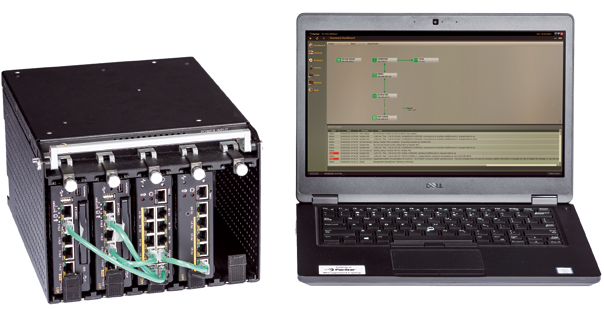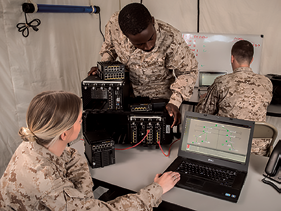Cyber has emerged as a new warfighting domain. From fears of Russian hackers disrupting tactical networks to ISIS threatening a global cyberattack, the risk continues to grow as adversaries are now equipped with cyber and electronic warfare (EW) capabilities.

Accordingly, the Department of Defense (DoD) is now considering cyber at the same level as traditional land, sea and air warfighting domains.
At the same time, the inevitable shift underway to an Internet of Battlefield Things (IoBT) multiplies cyber risks. In a new paper by Alexander Kott, chief of the Network Science Division at the Army Research Laboratory, he surmises that, “numerous, artificially intelligent, networked things will populate the battlefield of the future, operating in close collaboration with human warfighters, and fighting as teams in highly adversarial environments.”
More interconnected devices and sensors on the battlefield introduce cyber vulnerabilities that U.S. adversaries can exploit for maximum damage.
For these reasons and others, delivering cybersecurity on the battlefield and in tactical settings to guarantee secure communications offers a unique challenge, as the DoD must overcome a variety of factors including:
• Limited Visibility into Cyber Threats
Cybersecurity technologies today are too large and expensive to deploy. The result is that tactical networks are not equipped with the mobility and scalability needed in a cyber warfighting environment. Without the correct technologies in place, soldiers’ views into the threat landscape can be restricted and even at times inaccurate, as real-time situational awareness of cyber threats is impaired
• Shortage of Cybersecurity Skills in Tactical Settings
A response to cybersecurity threats on the battlefield must come in real-time, as the difference between waiting hours and days versus seconds and minutes to respond could have dire consequences. Yet the shortage of cyber specialists that can be readily deployed and available in tactical environments makes real-time response difficult, if not impossible. And even for tactical operators in the field, maintaining multiple systems can be overwhelming.
• Poor Cybersecurity at the Edge
The electronic footprints of current tactical networks are often easy to discover. And the closeness of adversaries in battlefield environments makes it easier for communications to be intercepted, which is all the more heightened given how tactical networks are traditionally dispersed. Internal and external cyber threats at the edge of the network challenge the DoD when it comes to rapid detection and response.
It’s true that the DoD faces many challenges when it comes to the battle against cyber adversaries, but steps are being taken to close the gap. The U.S. Army, for example, continues to modernize its network, while the DoD raised U.S. Cyber Command to a unified combatant command, a move strengthened by the president’s request of $647 million for Cybercom in fiscal year 2018. This represents a 16 percent boost from the previous year, in efforts to help the command bolster its cyber capabilities.
A Solution to Address Cyber Gaps
Current gaps in tactical cybersecurity capabilities cannot be viewed solely as a manpower and policy challenge. Vendors must also step up to provide solutions and demonstrate what is possible.
One answer lies in using small form-factor (SFF) modular solutions that offer automated detection and response to cyber threats and address the unique conditions that warfighters face. PacStar develops and supplies advanced communications solutions for the DoD and recently partnered with Fidelis, a leader in automated threat detection and response, to launch a joint solution that helps fill gaps in cyber operational efficiencies in a warfighter environment where resources are limited.

The PacStar Tactical Fidelis Cybersecurity System is a small-form factor and ruggedized solution employed with response capabilities to protect the plethora of communication use cases that warfighters in the battlefield must handle, including vehicle mount, in-theater communications, forward operating base deployments, and executive communications.
Providing the Fidelis Elevate™ platform in a rugged compact, form factor, the system is ideal for meeting the demanding size, weight, power and reliability requirements necessary for military tactical cyber defensive operations. This includes pre-positioned cyber sensors and deployable “hunt mission” kits.
Network specialists are able to easily facilitate and manage tactical configuration and troubleshooting thanks to the system’s “single-pane of glass” approach to incident response, which is made possible by the implementation of PacStar IQ-Core Software.

Providing automated detection and response to cyber threats in tactical and deployable systems is key to secure communications. Moreover, the PacStar Tactical Fidelis Cybersecurity System is designed to address the specific limitations that make secure communications in the battlefield so difficult, including:
• Improving Situational Awareness — The system offers enhanced visibility to remote cyber defender support organizations that traditionally do not have the real-time insight necessary to support the warfighter environment, including threat analytics capabilities. High speed network security analytics means that network session metadata can be indexed and stored long term, equipping warfighters with a more complete picture of the threat landscape over time and thus the ability to more quickly detect patterns and flag abnormalities. And the compact, quick setup of the system means that capabilities can be quickly up and running to provide insight for today’s mobile warfighter. Such SFF modular solutions are key to addressing security gaps in the field where time, equipment and manpower are limited.
• Simplifying Incident Response Detection — Given the limited availability of cyber experts in the field, cyber incident response tools must be easy to implement and deploy. This system simplifies that process thanks to automated detection and validation of alerts. Moreover, the system determines the appropriate response and suggests to soldiers the best course for resolution. Such an approach equips entire units with integrated cybersecurity knowledge while limiting the number of warfighters having to undergo the extensive training typically shouldered by a cybersecurity specialist. Moreover, soldiers can confidently address cyberthreats immediately without having to waste precious time waiting for a cyber specialist to arrive and confirm or refute the proposed response.
• Bolstering Security at the Tactical Edge — The small size, weight and power of the system makes deployment at the edge possible. For networks traditionally lacking protection, this system provides real-time cyber threat detection and response. System capabilities include running malware detection and intrusion prevention. Warfighters are often hard-pressed to find such abilities in resource-constrained environments that typically characterize the modern-day battlefield.

The PacStar Tactical Fidelis Cybersecurity System is based on a PacStar 451 module that hosts analytics, management and sensor functions (see image on the previous page). With sizeable deployments, additional PacStar 451 and 455 modules can be added to provide large, long-term, meta-data storage requirements, offering flexibility as the environment evolves and warfighter needs change. Supplemented with PacStar 400-series routing and switching modules, the system can be delivered as a complete all-in-one solution.
Both PacStar and Fidelis have extensive experience supporting enterprise customers, federal civilian, defense, and intelligence agencies, as well as government integrators and defense industrial based contractors.
Beyond the military, the PacStar Tactical Fidelis Cybersecurity solution is ideal for field operations including Homeland Security, first responders, oil and gas companies, and other industries that face similar challenges as DoD. Confronting cybersecurity capabilities on the front line of tactical communications is an immediate need as the cyber threat continues to advance.

Securing communications across multiple devices and operating systems is no easy task, but it must be a priority for the DoD. Accordingly, vendors such as PacStar and Fidelis will continue to innovate and provide solutions to better equip the federal government to tackle the growing threat of cybersecurity.
Charlie Kawasaki is CTO for PacStar, developer of secure tactical communications solutions. He has 35 years’ experience in product development, software engineering, technology licensing, patent development, business development, product marketing, general management and M&A.
pacstar.com/
www.fidelissecurity.com/


